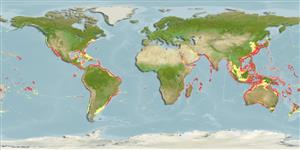>
Eupercaria/misc (Various families in series Eupercaria) >
Priacanthidae (Bigeyes or catalufas)
Eponymy: Dr Charles Montague Cooke Jr (1874–1948) was a malacologist at the Bishop Museum, Hawaii and Curator of the snail collection (1902–1948). [...] (Ref. 128868), visit book page.
More on author: Cuvier.
Environment: milieu / climate zone / depth range / distribution range
Ökologie
seewasser riff-verbunden; tiefenbereich 40 - 400 m (Ref. 9335), usually 165 - 200 m (Ref. 9335). Subtropical; 46°N - 56°S, 25°E - 5°W
Circumglobal in tropical and tropically influenced seas. Indo-Pacific: South Africa to the central Pacific islands, north to Japan and Korea, south to southeastern Australia. Eastern Pacific: Baja California to Peru. Western Atlantic: Nova Scotia, Canada (Ref. 47377) and New Jersey, USA to probably Argentina (Ref. 11441). Abundant at St. Helena but no substantiated records in eastern Atlantic from the African coastal region or the Canary Islands. Often misidentified as Cookeolus boops, a junior synonym of Heteropriacanthus cruentatus (Ref. 11441).
Size / Gewicht / Alter
Maturity: Lm ? range ? - ? cm
Max length : 69.0 cm NG Männchen/unbestimmt; (Ref. 89467); common length : 30.0 cm TL Männchen/unbestimmt; (Ref. 5217); max. veröff. Gewicht: 5.0 kg (Ref. 89467); max. veröff. Alter: 9 Jahre (Ref. 5403)
Rückenflossenstacheln (insgesamt) : 10; Rückenflossenweichstrahlen (insgesamt) : 12 - 14; Afterflossenstacheln: 3; Afterflossenweichstrahlen: 12 - 14. Last (10th) dorsal spine twice the length of the second (Ref. 48635).
Found on hard bottoms to a depth of about 400 m and reported to be moderately common at depths of 165 to 260 m in association with rocky holes and ledges; preferably with rich invertebrate growth such as sponges and soft corals (Ref. 48635). Benthopelagic (Ref. 58302). Juveniles pelagic (Ref. 9335, 9563). Feed on pelagic crustaceans (Ref. 9335). Probably spawns in the Caribbean from May to September. Solitary (Ref 90102).
Life cycle and mating behavior
Geschlechtsreife | Fortpflanzung | Ablaichen | Eier | Fecundity | Larven
Starnes, W.C., 1988. Revision, phylogeny and biogeographic comments on the circumtropical marine percoid fish family Priacanthidae. Bull. Mar. Sci. 43(2):117-203. (Ref. 5403)
IUCN Rote Liste Status (Ref. 130435: Version 2024-1)
Bedrohung für Menschen
Harmless
Nutzung durch Menschen
Fischereien: kommerziell; Sportfisch: ja; Aquarium: Kommerziell
Tools
Zusatzinformationen
Download XML
Internet Quellen
Estimates based on models
Preferred temperature (Ref.
123201): 12.2 - 21.8, mean 15.6 °C (based on 136 cells).
Phylogenetic diversity index (Ref.
82804): PD
50 = 1.0000 [Uniqueness, from 0.5 = low to 2.0 = high].
Bayesian length-weight: a=0.02089 (0.01101 - 0.03966), b=2.89 (2.73 - 3.05), in cm total length, based on LWR estimates for this species & (Sub)family-body (Ref.
93245).
Trophic level (Ref.
69278): 3.5 ±0.60 se; based on food items.
Widerstandsfähigkeit (Ref.
120179): mittel, Verdopplung der Population dauert 1,4 - 4,4 Jahre. (tmax=9).
Fishing Vulnerability (Ref.
59153): Low to moderate vulnerability (27 of 100).
Nutrients (Ref.
124155): Calcium = 24.3 [12.8, 50.6] mg/100g; Iron = 0.604 [0.353, 1.029] mg/100g; Protein = 20.1 [19.1, 21.1] %; Omega3 = 0.252 [0.148, 0.416] g/100g; Selenium = 30.1 [15.0, 57.6] μg/100g; VitaminA = 21.4 [7.2, 67.6] μg/100g; Zinc = 0.605 [0.411, 0.914] mg/100g (wet weight);
